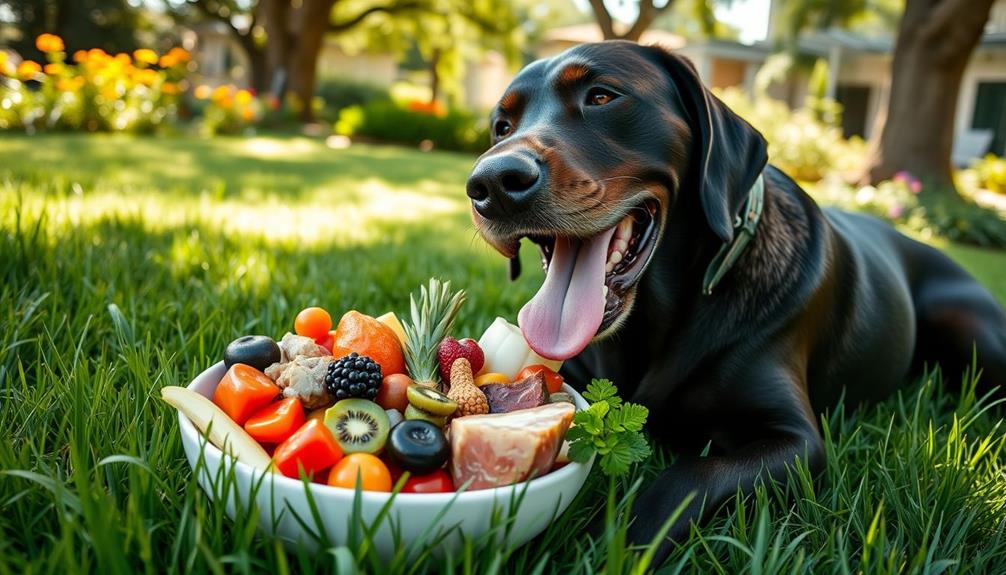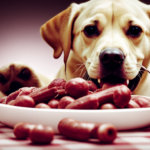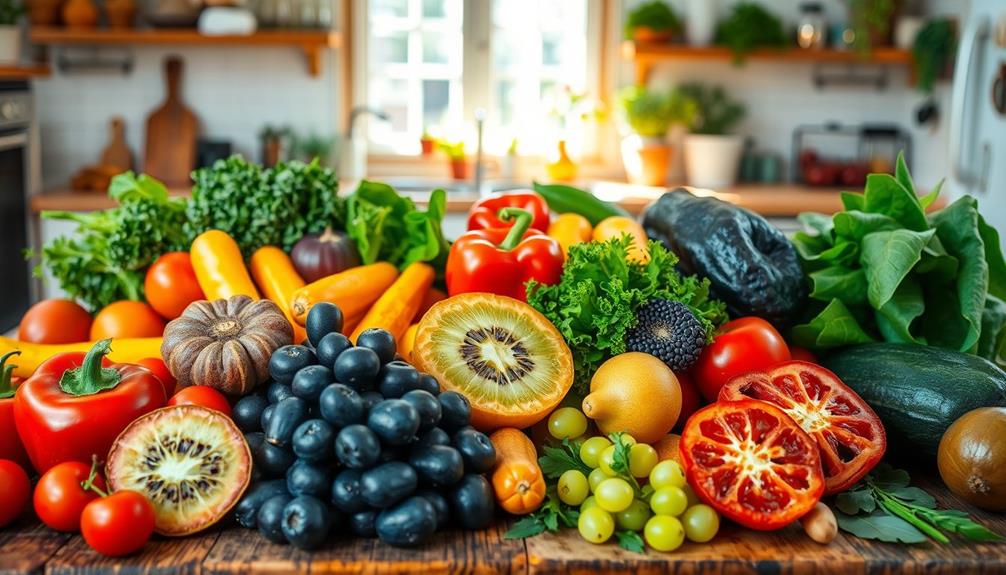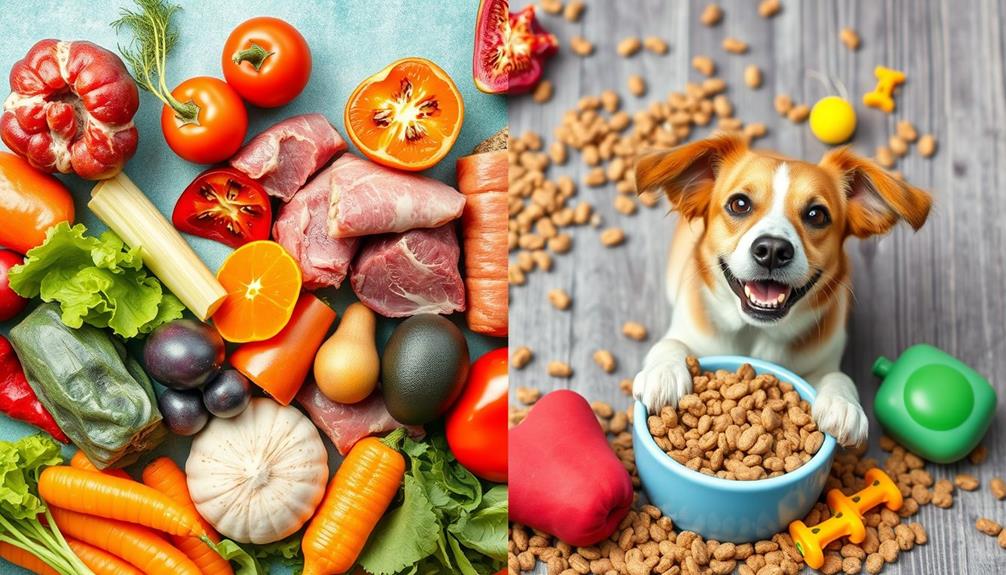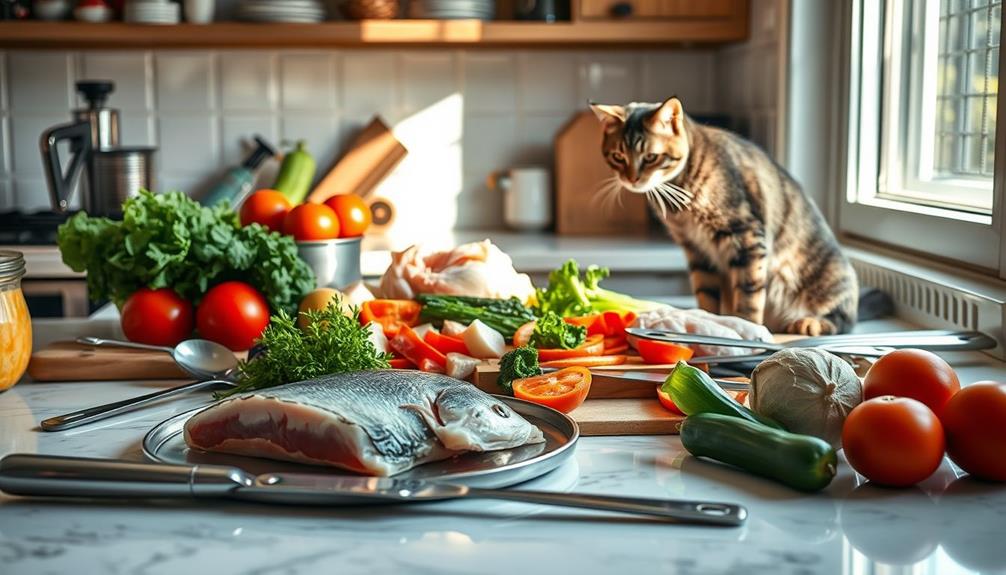Raw food can greatly boost your Labrador's health and vitality when done correctly. It offers benefits like better digestion, improved dental health, and increased energy levels. A balanced raw diet, rich in high-quality proteins and essential fatty acids, can keep your lab active and prevent obesity. However, you'll need to be cautious about safety risks, like bacterial contamination or nutritional imbalances, ensuring your dog's diet is well-structured. Shifting slowly is key for a smooth change. If you're curious about the best practices for feeding raw to your Labrador, you'll find more insight ahead.
Key Takeaways
- Raw food diets can improve Labradors' overall health, digestion, and energy levels while promoting better skin and coat condition.
- A balanced raw diet should consist of 70% protein and 30% vegetables/fruits, tailored to the dog's weight and activity level.
- Gradual transition to raw food is essential to prevent digestive upset and monitor health throughout the process.
- Safety concerns include bacterial contamination and the risk of nutritional deficiencies if the diet is not properly balanced.
- Regular weight assessments and portion control are vital to maintaining a healthy weight and preventing obesity-related health issues.
Benefits of Raw Feeding
When considering the best diet for your Labrador, raw feeding offers a range of benefits that can greatly enhance their health. One of the standout advantages is improved overall health, as a raw diet can lead to better digestion.
You'll notice smaller, firmer stools due to enhanced nutrient absorption, which is a sign of a well-functioning digestive system. Additionally, proper diet guidelines emphasize the importance of providing high-quality protein sources in your dog's meals.
Raw feeding also provides high-quality protein, essential for maintaining muscle mass and promoting healthy skin. This often results in shinier coats that you'll be proud to show off.
Additionally, raw diets can greatly benefit your dog's dental health by reducing plaque buildup and offering natural chewing opportunities, which helps keep their teeth clean.
Feeding a raw diet aligns with your Labrador's natural anatomy and digestive needs, ensuring they receive species-appropriate nutrition.
Many owners have reported a reduction in allergy symptoms and improved energy levels in their pets when switching to raw feeding, indicating further benefits for overall well-being.
Nutritional Needs of Labradors

Understanding the nutritional needs of Labradors is fundamental for their overall health and well-being. These active dogs require a diet rich in high-quality protein to support muscle maintenance and repair. A protein-rich diet mimics their ancestral eating habits, guaranteeing they thrive.
Essential fatty acids, particularly omega-3s, play a significant role in maintaining healthy skin and coat, while also supporting joint health, which is critical for Labradors due to their predisposition to hip dysplasia. Additionally, proper nutrition can help mitigate health issues common in Labradors, such as obesity and joint problems, making it important to take into account cold medications overview if these arise.
While Labradors can benefit from small amounts of carbohydrates found in vegetables and fruits for fiber, their primary focus should be on protein. When evaluating raw diets, it's imperative to verify they're nutritionally balanced, incorporating appropriate ratios of muscle meat, organs, and bones to meet their specific dietary needs.
Additionally, hydration is essential for Labradors, and raw food typically contains around 70% moisture, which can help maintain their hydration levels. By focusing on these nutritional requirements, you can help your Labrador lead a healthier, more active life, free from the common ailments that can arise from improper nutrition.
Types of Raw Feeding Diets
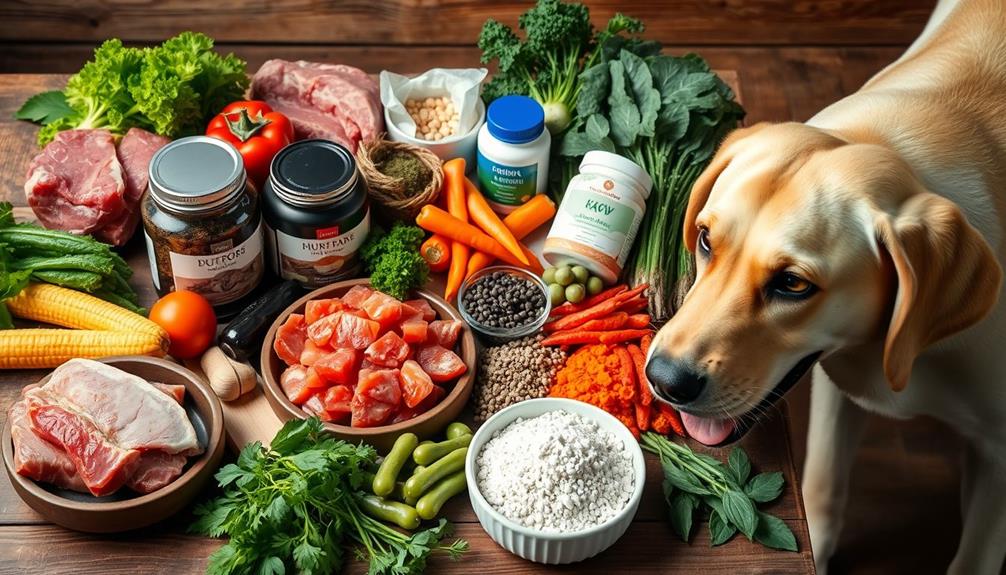
Raw feeding diets for Labradors come in various forms, each catering to different nutritional philosophies and preferences. Here are some popular types you might consider:
– BARF diet: This Biologically Appropriate Raw Food approach includes ground or pureed vegetables along with meat, providing a diverse range of nutrients.
Studies suggest that a well-balanced diet can support overall health and wellness, much like the benefits of herbal teas for humans, such as the best herbal tea for period pain.
- Raw Meaty Bones (RMB): Focused on whole carcasses, RMB diets offer minimal plant content and are rich in protein sources, essential for your Labrador's growth and energy.
- Prey Model: This model mimics the diet of wild canines, emphasizing raw meat and bones without any additional plant matter, promoting a species-appropriate diet.
- Rotating protein sources: Switching between different protein sources can help guarantee balanced meals and prevent food allergies, keeping your pup healthy and happy.
- Commercial raw: These prepared options simplify the feeding process, guaranteeing nutritional balance while providing convenience for busy dog owners.
Safety and Health Risks
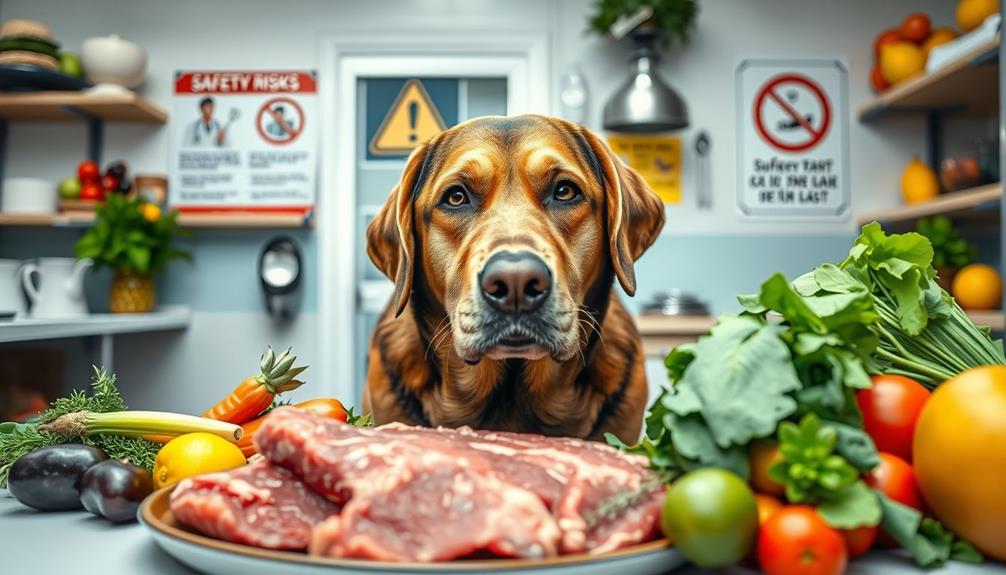
Feeding your Labrador a raw diet can come with significant safety and health risks that you should be aware of. One major concern is bacterial contamination from raw meat, which can harbor pathogens like Salmonella and Campylobacter, leading to gastrointestinal infections.
Abruptly switching to this type of diet can also cause gastrointestinal upset, so a gradual shift is imperative to guarantee your dog's digestive stability.
Additionally, whole bones can pose choking hazards or lead to dental fractures and internal injuries if not carefully monitored. You must also consider the nutritional aspects; an unbalanced raw diet may result in nutritional deficiencies, particularly in essential nutrients like calcium and phosphorus, which are critical for your Labrador's health.
Moreover, while many raw diets are high in protein, this might be unsuitable for Labradors with underlying kidney or liver issues, necessitating careful dietary considerations.
It's essential to weigh these health risks before committing to a raw diet for your Labrador, ensuring you provide a safe and balanced approach that supports their overall well-being.
Practical Feeding Guidelines

When feeding your Labrador a raw diet, it's vital to guarantee nutritional balance by incorporating high-quality proteins, essential fatty acids, and some carbohydrates from veggies and berries.
Including healthy dog snacks can also supplement their diet and offer variety.
Start the shift gradually to avoid digestive upset, adjusting the ratios until your pup is fully on raw food.
Regularly check your dog's weight and tweak their portions to keep them healthy and fit.
Nutritional Balance Requirements
To achieve a balanced diet for your Labrador, aim for a composition of about 70% protein sourced from meat, bones, and offal, while the remaining 30% should include small amounts of vegetables and fruits for essential fiber and vitamins.
This raw dog food approach guarantees a complete nutritional profile that supports your dog's health, much like proper piercing care and hygiene is essential for maintaining healthy piercings.
When planning your Labrador's meals, consider these practical guidelines:
- Include at least three different protein sources to avoid deficiencies.
- Aim for a daily raw food intake of 2-3% of their body weight (about 500g – 720g for a 25KG – 36KG dog).
- Use supplements to fill any nutritional gaps in homemade raw diets.
- Prioritize vitamins and minerals to promote overall well-being.
- Consulting a veterinarian or pet nutritionist can help tailor the plan to your dog's unique needs.
Transitioning to Raw Diet
Shifting your Labrador to a raw diet can seem intimidating, but with a structured approach, it becomes manageable and beneficial. Start by gradually moving to raw over ten days. Begin with a mix of 25% raw and 75% of their current food for three days. Then change to a 50/50 mix for another three days, followed by 75% raw for three more days before fully changing.
It's crucial to monitor your dog's overall health during this time, as a balanced diet with diverse protein sources guarantees they receive adequate nutrition and avoids issues like nutrient deficiencies.
A general guideline for feeding raw is to provide 2-3% of your dog's body weight daily; for example, a 25 kg (55 lb) Labrador would need about 500g to 720g of food each day. During this process, monitor your dog's tolerance and make adjustments as necessary.
Guaranteeing a variety of protein sources is crucial for maintaining balanced nutrition and preventing dietary boredom.
Utilize tools like We Feed Raw's food calculator to determine precise feeding amounts based on weight, age, and activity level. Always verify that the raw diet is complete and balanced according to FEDIAF-approved recipes.
Weight Management Strategies

Maintaining a healthy weight for your Labrador is imperative, as even a few extra pounds can lead to significant health risks. Implementing effective weight management strategies can set your pup up for a happier, healthier life.
A raw dog food diet can be a great tool in this process, especially when it includes nutrient-rich ingredients like chia seeds that promote digestion and hydration. Tailor your Labrador's daily food intake based on their metabolism, activity level, age, and overall health. Typically, this ranges from 500g to 720g for dogs weighing between 25KG and 36KG.
Regular weight assessments are essential to guarantee your dog stays within a healthy weight range.
- Obesity can rob your dog of its energy.
- A happy Labrador is an active Labrador.
- Healthy weight supports a longer, fulfilling life.
- High-quality raw food provides the necessary proteins and fatty acids they need.
- Recreational bones can keep your dog engaged and help maintain their weight.
Frequently Asked Questions
Is Raw Food Good for Labradors?
Raw food can be beneficial for your Labrador, improving digestion and coat quality. However, you need to guarantee a balanced diet, handle food safely, and be aware of potential health risks associated with raw feeding. It’s also important to remember that raw food diets for Labradors should be tailored to their specific nutritional needs and not just based on what works for other animals. In addition, consulting with a veterinarian before introducing raw foods for cats is essential to ensure that all of their dietary requirements are being met and to minimize the risk of any potential health issues. Overall, while raw food can be a positive addition to your Labrador’s diet, it’s crucial to approach it with caution and knowledge to ensure the best results for your pet’s health.
Is Raw Meat Good for Labs?
Raw meat can be beneficial for your Labrador, providing essential protein and hydration. Just make certain you balance their diet with muscle meat, organs, and bones, and handle the food safely to avoid contamination.
Do Vets Recommend a Raw Diet for Dogs?
While some vets might back raw diets, they're cautious. You'll need to consult a veterinary nutritionist to guarantee your dog's getting balanced nutrition. Remember, it's essential to handle raw food safely, like a pro chef!
What Is the Best Diet for Labradors?
To keep your Labrador healthy, focus on a balanced diet featuring high-quality proteins, healthy fats, and moderate carbohydrates. Make certain you provide the right proportions, and consult your vet to tailor their nutrition to their needs.
Conclusion
To summarize, raw food can be a nutritious option for your Labrador, but it's crucial to understand their specific needs. Have you considered how a balanced raw diet might improve your furry friend's health and well-being? By ensuring you follow proper guidelines and safety measures, you can help your Labrador thrive. Always consult your vet before making any drastic changes to their diet, so you can confidently provide the best for your loyal companion.

